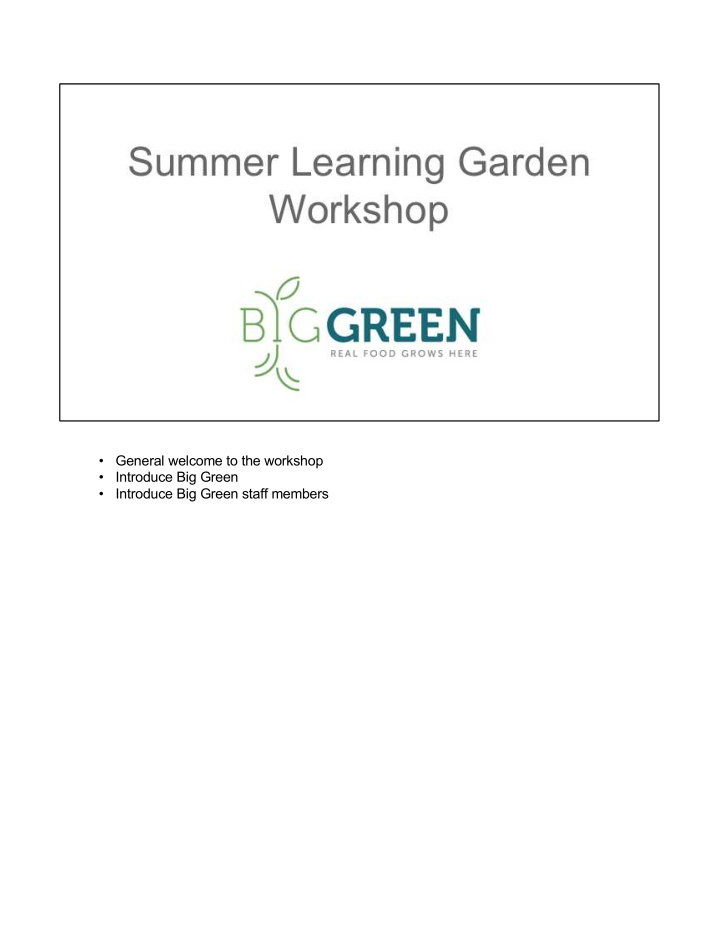



• General welcome to the workshop • Introduce Big Green • Introduce Big Green staff members
- Introduce Pico de Gallo- using ingredients that you can harvest from your summer garden - Think about how you could do this recipe with your class- a little prep beforehand, have students measure, rip cilantro, mix, and taste. - Mention EWYG - you should be EWYG certified if you are making a classroom recipe with garden produce - The recipe is from our tasting activities. - Have groups introduce themselves to each other while building the recipe- name, school, role/grade level - Also while making the pico and eating, groups can talk about how things are going in their spring gardens.
- You can find the pico recipe that you just made on our website under the teaching in your garden tab, then garden skills and lessons
You can also search the Greenhouse for recipes!
Use those spring veggies!!
Benefits to them and us - We ask schools to track their harvests…why? - Understanding how much your garden produces will help you anticipate the harvest in future seasons (workload, how to distribute harvest, how many people can be involved, etc.) - Share your accomplishments (people love numbers…weight, number of servings, etc.; think about where/how to share this info) - Increase your harvest (great way to get people excited about helping to accomplish a collective goal) - We’re asking teachers to share this info with us; it helps prove the impact we’re making at Big Green and in exchange, we’ll provide you with a summary of all your harvests so you don’t need to keep track from week to week - 2 Amazon gift cards, 1 Women & Children First Gift Card will be raffled off
• Example of the report you’ll receive • Note that the report converts all the quantities to servings (even if you’ve used a variety of units of measurement, such as lbs + bags + individual items • Mention that submitting their data is a great way to let us know that they’re harvesting regularly, which puts them on our radar for Garden Bites
These are the spring harvest totals reported by just 37 schools!
• To submit harvest info: after you get to the home page, head to the “Teaching in Your Garden” tab and click on “Garden Skills and Lessons”
- Fill out this sheet outside, then come inside to submit your data online - Non-standard measuring tools: point out that you can quantify your harvest in a variety of ways (pounds, individual items, gallon bags, buckets, etc.)
Basic steps to transitioning to a summer garden, we’ll talk more in depth about each of these in the following slides
Explain the how and why of where we’ve placed certain things: tall sunflowers in the middle, scarlet runner beans alongside to climb, northeasteri beans on one edge, etc. Note that they don’t have to follow this exactly!
Why grow cover crops in your Learning Garden? Aristotle had a phrase that translated to “Nature hates a vacuum”, which in gardening means that if you don’t intentionally plant something, a plant that you do not want (AKA weed) will likely grow in that space. So the practice of cover cropping serves to keep the planting space occupied with plants that have many benefits. Benefits of Cover Cropping: Soil moisture retention Maintains and improves soil structure Maintains and improves soil biology Legumes and Nitrogen Fixation Retains and improves soil nutrients Beautiful Low maintenance Inhibits weed growth Cover Crop Arrangement & Why Sunflowers- grow very tall Runner beans- use the stalk of the sunflower to climb and anchor Nasturtium- will grow over the side of the bed, good to plant in the corners Bachelor's Button & Zins: Shorter flowers good to plant at the sides of bed
Northeaster Beans Don’t let the cover crop plan intimidate you! Getting seeds planted is better than following the cover crop plan to a tee because you don’t want to give weeds time and space to grow.
Basic steps to transitioning to a summer garden, we’ll talk more in depth about each of these in the following slides
• We’re setting schools up to plant on their own with our Chicago Garden Plan (full plan on website); provide brief overview of plan • Decide which summer plan will be best for your school; will there be people around to care for the garden?
- Talk through the three different summer garden themes, as well as the summer cover crop option. - Now that it’s late May, you can plant summer crops as soon as you’re done with the spring garden - We’ll be demonstrating how to plant the summer crops outside in a bit, and note: harvesting info is at the end of the summer garden plan; videos are also available - Everything in the garden will transition to summer plantings, except for perennial herbs and garlic.
- Explain: - How to know when garlic is ready to harvest: when 1/3 – ½ of leaves have turned brown and died - Harvesting garlic scapes: immature flower buds, a bonus that you can use just like garlic, ready to harvest when scapes fully curl, ready about a month before the garlic - Harvesting garlic bulbs: loosen the soil around the bulbs with a hand trowel or small shovel, pull the bulb out of the ground, don’t pull high on the neck - Storage: brush off soil (don’t use water!), hang in a dry warm place out of direct sun for at least 2 weeks to cure, then you can braid or cut off the stems
- Impact Map: Pull up the impact map and navigate through how to add layers to find summer meal distribution sites, food pantries, farmers markets, etc.
Recommend
More recommend